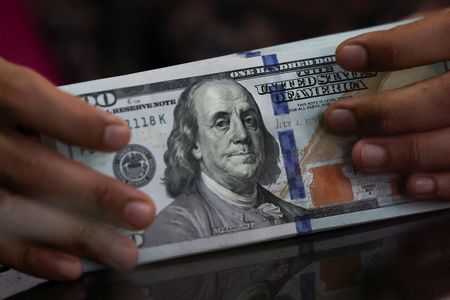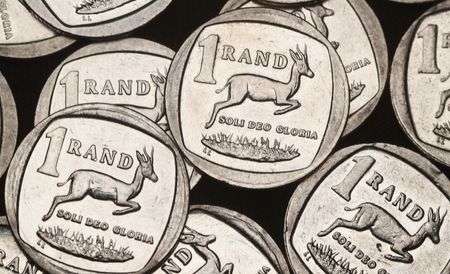By Sinéad Carew and Marc Jones
NEW YORK/LONDON (Reuters) -Declines on Wall Street dragged MSCI’s global equities lower and U.S. Treasury yields rose as investor hopes for a Federal Reserve rate cut took a dive and officials pointed to a lack of clarity in economic data as the U.S. government ended its longest-ever shutdown.
In currencies, the dollar also turned lower, despite hawkish statements from Fed officials after the House of Representatives voted to reopen the U.S. government late on Wednesday and President Donald Trump signed the bill.
Investors have been buying equities in recent sessions in anticipation of a U.S. government reopening after its record 43-day shutdown, which disrupted food benefits for millions, left hundreds of thousands of federal workers unpaid, and snarled air traffic while putting a pause on crucial economic data releases.
However, Trump administration officials dashed hopes for a clearer view of the U.S. economy any time soon.
White House economic adviser Kevin Hassett told Fox News that while the government will have a jobs number, data on the U.S. unemployment rate for October may never be available because it is dependent on a household survey, which was not conducted during the government shutdown.
Minneapolis Federal Reserve President Neel Kashkari said he sees mixed signals from the economy, with inflation, running around 3% and was “too high”, and that parts of the labor market “look like they’re under pressure”.
San Francisco Federal Reserve President Mary Daly on Thursday said the risks to the Fed’s two goals are balanced now that the Fed has cut interest rates twice this year. She added that services inflation has not been declining at a steady rate and that there was more concern that labor demand will continue to slow.
TRADER BETS ON RATE CUTS TUMBLE
All of this sent trader bets on a December rate cut tumbling to a 49.6% probability from 62.9% on Wednesday, according to CME Group’s FedWatch tool.
“What you’re seeing today is a risk-off assessment. We’re still going to get a cloudy picture on economic data. It’s not going to be complete and the Fed may not cut rates in December because of that,” said Anthony Saglimbene, chief market strategist at Ameriprise.
With the market already showing signs of concern about high valuations in heavyweight technology and artificial intelligence-linked stocks, he said it was not surprising to “see investors take a step back from risk, sell down the winners and go into the defensive areas of the market”.
As of 12:22 p.m. on Wall Street, the Dow Jones Industrial Average fell 451.61 points, or 0.94%, to 47,803.21, the S&P 500 <.SPX> fell 80.00 points, or 1.17%, to 6,770.79 and the Nasdaq Composite fell 429.28 points, or 1.83%, to 22,977.17.
MSCI’s gauge of stocks across the globe fell 8.01 points, or 0.79%, to 1,003.77.
PAN-EUROPEAN STOXX 600 INDEX HITS RECORD HIGH BEFORE FALL
After hitting a record high earlier, the pan-European STOXX 600 index fell 0.61%, while Europe’s broad FTSEurofirst 300 index fell 15.41 points, or 0.66%.
In U.S. Treasuries, prices were down, pushing yields higher, as investors scaled back expectations for imminent rate cuts amid lingering uncertainty over the inflation outlook and stark divisions among Fed policymakers on the trajectory of the U.S. economy and monetary policy.
The yield on benchmark U.S. 10-year notes rose 1.7 basis points to 4.096%, from 4.079% late on Wednesday while the 30-year bond yield increased 2.1 basis points to 4.683%. The 2-year note yield, which typically moves in step with interest rate expectations for the Federal Reserve, rose 1.9 basis points to 3.585%.
In currencies, the dollar index, which measures the greenback against a basket of currencies including the yen and the euro, fell 0.46% to 99.02, with the euro up 0.51% at $1.1651.
Against the Japanese yen, the dollar weakened 0.3% to 154.31.
Sterling strengthened 0.59% to $1.3207, shrugging off data showing the British economy was barely growing. The Australian dollar strengthened 0.17% versus the greenback to $0.6549 as strong employment figures bolstered bets its rate-cutting cycle may be over.
In energy markets, oil futures recouped some of the major losses suffered in the previous session, as investors weighed concerns about global oversupply with looming sanctions against Russia’s Lukoil but gains were pared after data showed larger-than-expected U.S. crude oil inventory buildup.
U.S. crude rose 0.6% to $58.84 a barrel and Brent increased to $63.13 per barrel, up 0.69% on the day.
Gold prices edged lower after earlier climbing to an over three-week high as hopes faded for a Fed rate cut next month.
Spot gold was flat to $4,198.40 an ounce. U.S. gold futures fell 0.25% to $4,194.00 an ounce.
(Reporting by Sinéad Carew in New York, Marc Jones, Stephanie Kelly in London; editing by Sharon Singleton and Ed Osmond)











